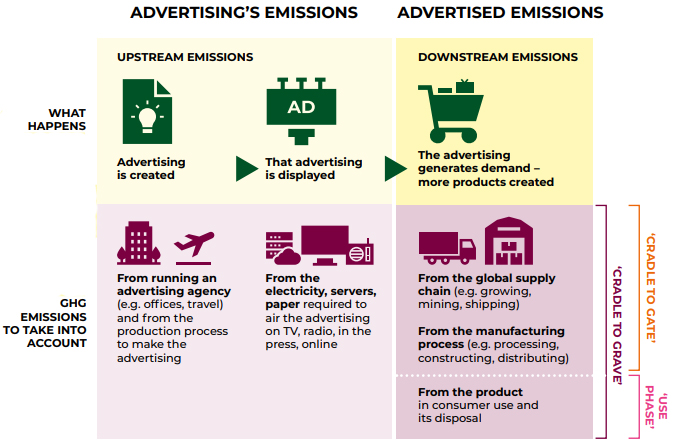At COP26 in the BlueZone the team at Purpose Disruptors passionately made the case for Advertised Emissions to be adopted by the industry to ensure the UK’s efforts of achieving net zero were to be realised... But what does this actually mean and does it detract or enhance the industry's current initiatives?
The Purpose Disruptors team clearly outlined the following definitions within the report which can be found here in summary:
- Advertising’s Emissions: The emissions created with the production and placement of advertising.
- Advertised Emissions: Are the Greenhouse Gas emissions that result from the uplift in sales generated by advertising.

For Advertising’s Emissions, the industry has started to calculate and understand the carbon footprint of production and the impact of media strategy and buying decisions on the carbon footprint of a plan. 2022 will see agencies now focus on taking those learnings and apply new techniques and approaches to start to reduce our carbon footprint vs relying on the short term solution of offsetting.
The next step after this is the recognition of Advertised Emissions, the debate can quickly become about who is responsible and accountable for them? For example why should a media agency account for its client global supply chain emissions in the work that it does. However this can be an unproductive tangent. The success of the Advertised Emissions concept is that it makes agencies start to think of themselves as the protagonists within the industries climate story versus a compliant supplier minimising their impact and influence. It's the mindset shift required for a more transparent and holistic approach that will help our industry evolve and position us as leaders in shaping a net zero society.
Understanding of the Advertised Emissions enables agencies to start a more holistic discussion about the climate impact of our industry. Examining the work we do through a sustainable lens and the types of demand we drive amongst consumers opens up a new approach to marketing and media. Most importantly it gives us an opportunity to understand our clients business more deeply and in turn to discover what meaningful reduction of emissions looks like.
The findings of the influential Climate Change Committee Sixth Carbon Budget report provides further rationale of why we should consider our climate impact. For the UK to achieve its 2050 net zero ambition (and slash emissions by 78% by 2035) at least 16% of that emission reduction will come from behavioural change. That behavioural change means consuming less and consuming products and services designed to thrive in a net zero society - as a key agent of demand this squarely places responsibility on all of the stakeholders that create demand and those that craft and promote the aspirational lifestyles that consumers identify with.
It is a challenging but necessary discourse as we aim to disentangle advertising’s ability to drive growth at all costs with the legacy high carbon lifestyles we have grown accustomed to. and start to embark on a journey of responsible consumption and what that means for all parties in the supply chain.
However, when you have a collective and ambitious goal you open up the possibility of innovation, discovery and a chance to exceed expectations. As the IPA Climate Charter states this is about a pathway for sustainable transformation within the industry. Transformation requires fundamental and lasting change. That is why Advertised Emissions provides an exciting, fact-based starting point to reevaluate and redefine the ‘value of advertising’ within society and as the role we play in addressing climate change.